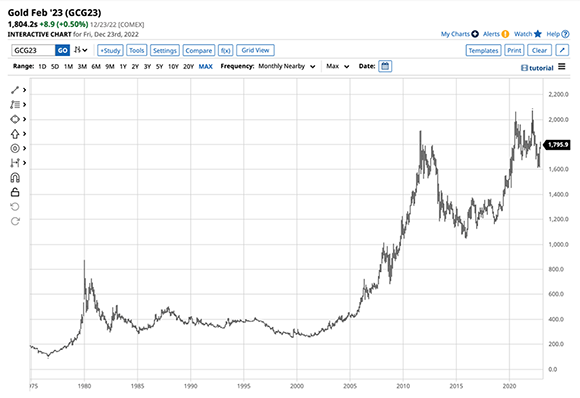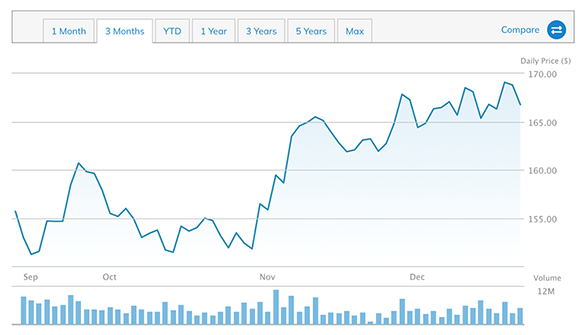
To quote the villain Goldmember from the 2002 Austin Powers’ installation: “I love gold.”
Goldmember loved everything about gold, saying he adored “the look of it! The schmell of it! The tashte of it! The texture!” Goldmember would probably not endorse the SPDR Gold Trust (GLD), the most successful commodity ETF, but it could be the most attractive ETF products for 2023.
Goldmember was a spoof of Ian Fleming’s 1964 James Bond Classic, Goldfinger. Fleming himself had a connection to the yellow metal. In 1949, he met Charles W. Engelhard Jr., a South African mining mogul. Engelhard had established a business partnership with Harry Oppenheimer and his firm DeBeers. Engelhard and Oppenheimer made fortunes in gold and diamond mining. Fleming and Engelhard became acquaintances, and the global industrialist’s lifestyle became so enthralling to Fleming that it inspired his 1959 Bond character, Goldfinger.
More Than a Commodity
Gold’s bull market began in 1999, and I expect it to continue to make higher lows and higher highs in 2023.
The precious metal is an excellent heat and electrical conductor used extensively in electronics in printed circuits and transistors. The circuitry of computers, calculators, televisions, telephones and fire detectors often have gold plating.
Gold is also essential for dentistry and fabricated demand or jewelry manufacturing accounts for a significant amount of annual industrial gold requirements. However, gold is the world’s oldest means of exchange, making the metal a hybrid between a financial asset and a commodity.
Central banks, monetary authorities, governments, and supranational institutions hold gold as an integral part of foreign currency reserves, validating gold’s role in the global financial system.
The 1999 “Brown Bottom”
In the late 1990s, gold was in a bearish trend of lower highs and lower lows since the 1980 record $875 per ounce all-time peak. The 1990s was a decade where gold mainly traded in a $300 to $400 range.
London is the global hub of international gold trading, and the Bank of England is a leading international regulator. Therefore, the U.K.’s decision to sell half of its gold reserves was a blow to gold’s position in the global financial system as the British government cast gold as a barbarous relic of yesteryear.
The U.K. auctioned gold from 1999 through the early 2000s, pushing the price to a $252.50 low, which became the metal’s “Brown Bottom,” as the Chancellor of the Exchequer and future Prime Minister Gordon Brown was responsible for selling a significant part of England’s national treasure.
Other worldwide central banks did not follow the U.K., and gold embarked on a bullish path that took the price over eight times higher over the past twenty-three years.
Source: Barchart
(For a larger view, click on the image above)
The chart shows the bullish path of COMEX gold futures that made higher lows and higher highs since 1999, with the precious metal breaking to the upside in 2008 when it rose above the 1980 high.
Gold Outperformed Stocks in `22
Gold traded above $2,070 per ounce for the first time in 2022, ranging from $1,613 to $2,072. The midpoint of this year’s trading band is at $1,842.50, with gold sitting at around the $1,800 level on December 23. Meanwhile, gold closed 2021 at $1,827.50.
At $1,800, the price was down only 1.5% as of late December, a victory compared to other markets. Stocks, bonds, cryptocurrencies, real estate, and most other asset classes suffered more significant losses in 2022. Moreover, rising interest rates and a strong U.S. dollar typically weigh on gold. Since 2022 was anything but an ordinary year, gold’s price held up well compared to other asset classes.
In this year’s third quarter, the world’s central banks were net buyers of nearly 400 metric tons of gold, a record. Over the first nine months of 2022, total official sector purchases were at the 673-ton level, the highest since 1967.
A Case for Gold in `23
As the gold market moves into 2023, the following factors support gold, the world’s oldest currency:
-
Inflation remains at the highest level in decades, and gold has a long history as a store of value when currencies’ purchasing power declines.
-
Gold trades in U.S. dollars. The dollar rallied as short, medium, and long-term interest rates soared in 2022. While Fed officials are nearly unanimous with forecasts of short-term rates at over 5% in 2023, the Fed Funds Rate is already at a midpoint of 4.375%. The trajectory of rate increases will be far lower in 2023 than in 2022.
-
The rising odds of a U.S. recession could cause the U.S. central bank to curb its enthusiasm for rate increases over the coming months.
-
Russia is the world’s third-leading gold-producing country, behind China and Australia and ahead of the United States. The war in Ukraine, sanctions and Russian retaliation might pinch supplies and boost prices.
-
In 2022, Russia announced, “In order to balance supply and demand in the domestic market of precious metals, the Bank of Russia will buy gold from domestic credit institutions at a fixed price of 5,000 Russian rubles per gram from 28 March to 30 June, 2022.” The ruble recovered against the U.S. dollar in the aftermath of the announcement.
-
The bifurcation of the world’s nuclear powers, with Russia/China on one side and the U.S./Europe on the other, could diminish the dollar’s role in the global financial system. If China follows Russia and establishes a gold standard, gold’s role will rise further.
-
Gold’s 2022 performance considering a strong dollar and higher interest rates testified to its underlying strength.
Meanwhile, since the 1999 “Brown Bottom,” gold has been in a bullish trend, with every significant correction a buying opportunity.
GLD Tracks the Metal’s Price
The most direct route for gold investment is the physical market for bars and coins. The COMEX futures provide a physical delivery mechanism causing prices to converge with physical prices during delivery periods.
In 2004, the SPDR Gold Trust (GLD) was the first commodity ETF product. GLD gained widespread acceptance as it holds physical gold bullion.
At $167.26 on December 23, GLD had $53.4 billion in assets under management. GLD trades an average of over five million shares daily, making it a highly liquid product, and charges a 0.40% management fee.
Nearby COMEX gold futures rose from $1,613 in September 2022 to a high of $1,821.40 in December 2022, a 13% increase.
Source: ETF.com
(For a larger view, click on the image above)
Over the same period, GLD rose from $151.03 to $169.79 per share, or 12%. Gold trades around the clock during the business week, while GLD is only available when the U.S. stock market operates. Therefore, GLD can miss highs or lows during Asia or European trading hours.
Austin Power’s Goldmember and Ian Fleming’s Goldfinger loved the yellow metal, and there are many reasons to adore the commodity that is a leading financial asset as we head into 2023.
Recommended Stories
Read More:GLD Could Surprise on the Upside in 2023
2022-12-27 20:15:00


